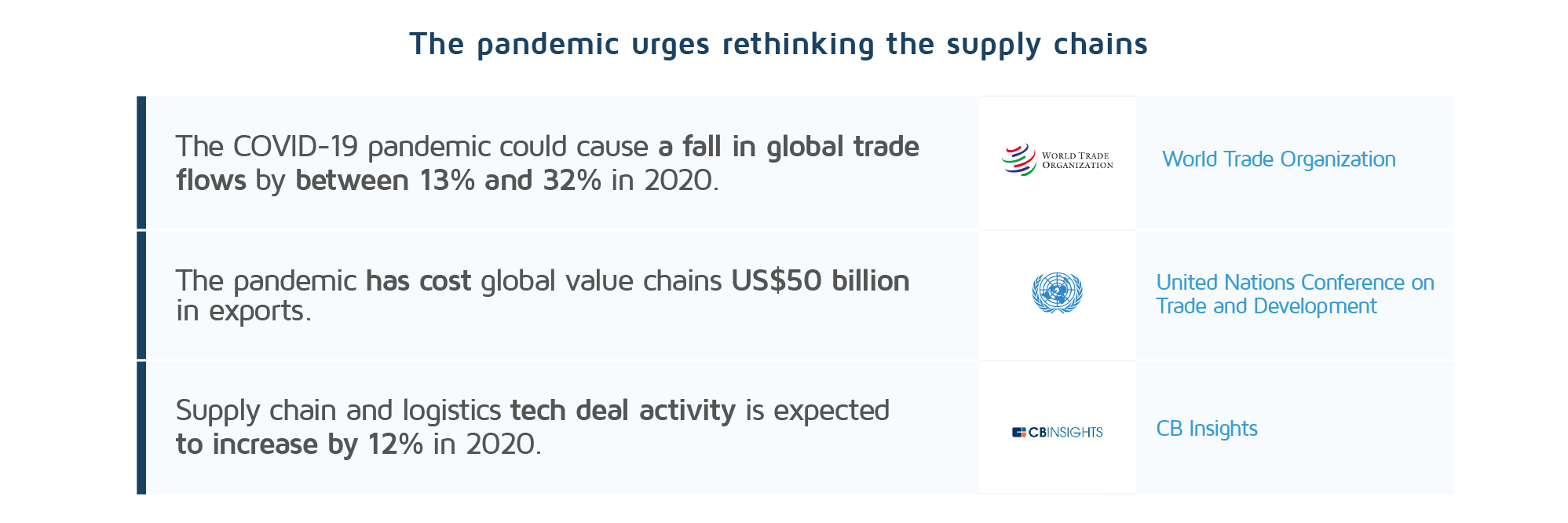By causing disruptions never before experienced, the pandemic crisis has revealed the fragilities of global supply chains. Businesses and governments have found themselves facing the need to reset a complex ecosystem. Despite the needed liquidity injections governments and central banks have provided as an urgent response to acute needs, the optimal solution is a strategic approach in terms of building smarter supply chains and boosting economic recovery.
Reducing reliance, diversifying supply chains
Given China’s dominance in key areas of manufacturing, the delay in receiving orders from its shutdown-factories was inevitable. Currently, China accounts for 60% of global consumer goods exports and 41% of global technology, media and telecom (TMT) exports. The spread of the coronavirus has highlighted the risk of such a dependency prompting the need to seek out a more diversified supplier base. There is no simple substitute for China, but many companies have been working on reducing their reliance on Chinese goods over the last few years. China’s capacities cannot be replicated given the large numbers of skilled workers, huge supplier networks and a reliable infrastructure but the new approach is likely to accelerate the trend of reducing reliance on China’s manufacturing capability.
As a result of rising wages and costs, China had already lost a certain amount of global export market share in 2019, when companies looked to countries such as Mexico and Vietnam for low-cost production. At the expense of China, together, these two countries, succeeded in extending their market of consumer goods and TMT sectors to account for 12% and 9% of the total in 2019. Other manufacturing hubs such as India and Ethiopia are also likely to benefit from such a trend.
From globalization to regionalization
Companies should rely on a holistic approach when transforming traditional supply chain models into flexible but cost-efficient options. Policymakers and companies could be pressurized into considering the decentralization of manufacturing by boosting domestic production or supply chains could be renationalized or at least shortened to reduce the risks of global exposure.
It is likely that European governments that have imported 80% of the active components necessary for their drug supplies from China and India will make sure they can obtain the same supplies from within their own region because local manufacturing will strengthen a country’s capacity to future weather storms. Japan has already reconsidered the sustainability of its supply chains and allocated around US$2 billion for companies shifting production back home. Vietnam increased its production of face masks, exporting more than 415 million in four months, after China halted delivery of protective clothing, ventilators and medical supplies.
Recent data shows the devastating economic impact that demands concerted actions to rethink future supply chains and accelerate digitization.

Digitization, an essential focus in designing future supply chains
In view of the benefits such as reductions in cost, fewer barriers to innovation and an increase in the global logistics market, digitization is the most efficient approach to modernizing supply chains and the pandemic has already pushed governments and companies to innovate their digital operations. According to a McKinsey study, the average supply chain has a digitization level of 43%.
By digitizing supply chain flows and the documentation that supports it, businesses will achieve a more optimized and autonomous system. Offering an attractive Return of Investments means that immediate action should be taken with the digitization of global trade raising supply-chain performance to new levels. An ambitious improvement in reducing supply chain barriers to trade could increase GDP up to six times more than removing tariffs, a report published on the World Economic Forum website suggests.
The pandemic crisis has accelerated the transformation of supply chains offering opportunities to strengthen the capacity of the global trade network to face future disruption to supply chains.
Gain access to the latest news by subscribing to DevelopmentAid. By becoming a DevelopmentAid member you can find information about tenders and grants on our platform.


